Balance changes have been announced, targeting some of the strongest cards in the current meta. With these changes, we expect the meta to undergo a massive shake-up.
As a result of the patch, our next Data Reaper Report is planned to be published on September 5th. Please consider helping us collect as much post-patch data as possible by signing up to contribute your games to the project. It’s very easy to do, and the more data we have, the better our insights will be.
How will the balance changes impact the Uldum meta? Which strategies will fall? Which strategies will rise? We’ll try to answer these difficult questions in this article and highlight one deck from each class that might be worth trying out on patch day!
You can post your own thoughts on the subject in our Discord Server.
First, let’s go over the changes themselves.
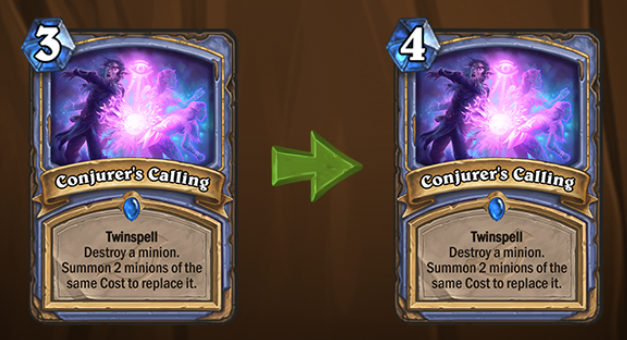
Conjurer’s Calling has been at the center of Mage’s success throughout the Year of the Dragon. Increasing its cost by 1 mana slows down the class’ arguably strongest play: Giant/Conjurer’s Calling. The fact that Conjurer’s Calling is a Twinspell makes the mana cost change even more impactful. Part of the reason Giant/CC is so powerful is that another CC will land the next turn if both threats are not immediately dealt with, and sometimes Khadgar joins the party, leading to a complete blow out. This change poses significant, widespread implications on every Mage strategy going forward since Conjurer’s Calling enables most of Mage’s biggest swing turns. It gives the opponent a better chance at responding to these power plays, or more time to pressure the Mage before Jaina can execute them. This is particularly relevant when taking the next change into consideration.
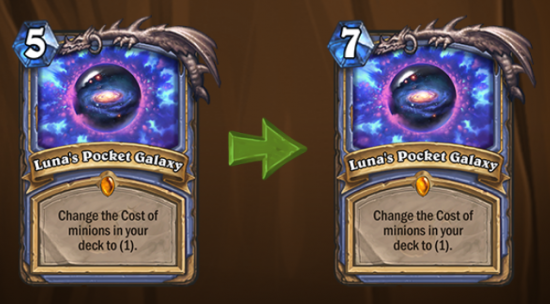
Luna’s Pocket Galaxy has become one of the most oppressive cards in the format in Saviors of Uldum. The card was so powerful when drawn by turn 5 that it warped the meta to focus on killing the Mage as quickly as possible. Slower strategies had little chance of overcoming the permanent effect Galaxy had on the game, and matchups were largely decided by the appearance of Galaxy as well as the high variance of outcomes depending on the Mage’s subsequent draws. Galaxy reduced player agency and led to blowout “non-games”, games in which decisions hardly mattered. It was also particularly overwhelming alongside Conjurer’s Calling. By reverting its cost back to 7 mana, it’s once again too slow and likely unplayable: as it should be.
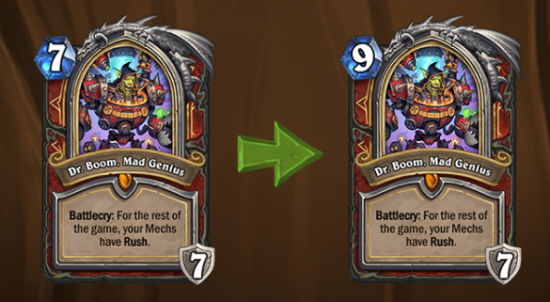
Dr. Boom dominated Standard format the moment Death Knights retired to Wild. The card became the strongest, standalone, late-game value engine in a field that no longer excelled in producing “infinite” value. But Dr. Boom’s strength is not just about its resource generation through hero powers. It’s also about its passive effect. Warrior excels at denying initiative from its opponents since most of its minions become immediate removal options with rush. It’s incredibly hard to ever keep a board against the Mad Genius, and with a cost of 7 mana, it was still one of Warrior’s strongest cards in aggressive matchups and always a good mulligan target.
Therefore, we think some players underestimate the impact of this change. Opponents have more time to pressure the Warrior before the aura can come into effect, and Warriors should also have more difficulties in finding the right time to play Dr. Boom. Since the card doesn’t have an immediate impact on the board, it can already be difficult to play it while being pressured. It should be more taxing to spend 9 mana to do the same thing, and we also can no longer use our hero power on the same turn we play it.
By costing 2 more mana, Dr. Boom remains a strong late game card that Control Warrior builds will still include without a second thought However, it is no longer the dominating force in faster matchups it has been. Initiative-focused decks will significantly benefit from this change.
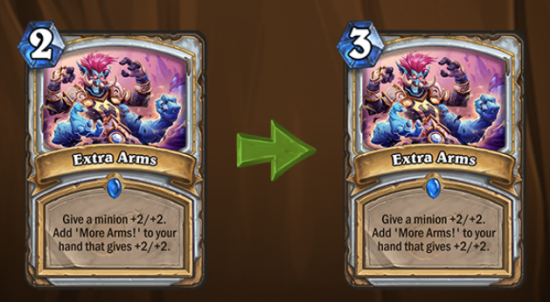
After its buff, Extra Arms became a very powerful card in a very weak class, and it was a matter of time until it found a deck that could abuse its early game potential. After Saviors of Uldum’s launch, Combo Priest took advantage of Extra Arms exceptionally well and quickly skyrocketed to the top of the meta.
Priest tends to be a snowball-y class. It’s very good at leveraging a board lead into a bigger advantage, and Extra Arms was the most powerful enabler at giving Priest that early lead. Hitting Arms on either Cleric or Lightwarden often led to the game spinning out of control and allowed Combo Priest to play very aggressively.
With Extra Arms costing 3 mana once again, the card is likely too weak to be played. Priest’s early game is now far less explosive, and its playstyle should be slower and more reactive. The tools the class has received in this expansion may keep Combo Priest competitive, but its ability to stomp opponents by turn 3 should be greatly reduced.
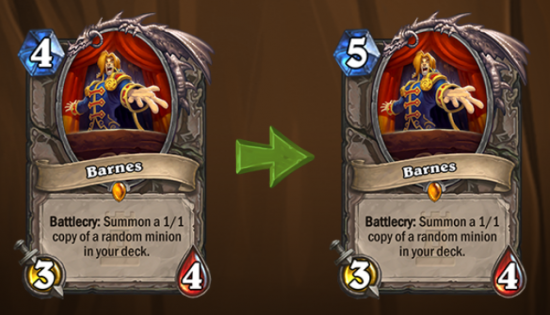
It finally happened. After being the subject of many complaints amongst the Wild community, Barnes has been nerfed. The card is inherently frustrating for the same reason Luna’s Pocket Galaxy is frustrating: it significantly reduces player agency and creates non-games in which decisions hardly matter once it’s drawn. By making it cost 5 mana, Big Priest’s most powerful turn is delayed, and that should have quite an impact on its performance. Big Priest hasn’t been a top-performing deck in the format for a while, and this change will make it even weaker and less common, especially at higher levels of play.
Mage is the class that has been hurt the most by the patch, seeing two of its strongest tools being hit. We think the change to Conjurer’s Calling is particularly debilitating to a deck like Cyclone Mage, since it’s much more reliant on hitting its CC turn. The deck is already somewhat lukewarm in the current meta and has been outclassed by Highlander Mage, so it’s unlikely to rise post-patch with its biggest power play being delayed by a full turn.
Highlander Mage has a better chance of remaining competitive, but it will likely have to change its build. The greedy Big-Spell package could be cut, as it’s far too slow outside of the context of Galaxy. Instead, Highlander Mage may look to solidify its curve, in order to be able to fight for the board better in the early to mid-game and not fall behind. It should still have enough threats to apply pressure in the late game, but it won’t just roll over opponents as before.
Warrior has certainly been hurt by the nerf to the Mad Genius, but it will likely stay strong. The change to Luna’s Pocket Galaxy, Conjurer’s Calling and Extra Arms gives Warrior a stronger matchup into Mage/Priest and will likely lessen the need for reactive mass-removal options such as Supercollider and Plague of Wrath. The patch may also bait the rise of aggressive decks, which will still find Warriors difficult to deal with, even when Mad Genius can no longer be counted on for faster matchups.
Bomb Warrior and Aggro Warrior have already surpassed Control Warrior’s performance on ladder, and this patch may accelerate this transition. There are several potential archetypes, previously suppressed by Mage and Galaxy/Calling, that can counter Control Warrior’s removal plan with strong value engines. Control Warrior has always been easier to target due to its more passive nature, and with a slower Mad Genius, its ability to pressure these decks will weaken further. Therefore, we really like the idea of a Bomb-Taunt Warrior deck that can get to the board faster and just punch you in the face.
Combo Priest will have to adjust due to the loss of its early game blowout potential through Extra Arms, but this deck shouldn’t be written off. We might consider cutting Lightwardens and making up for the weaker early game by improving our late game consistency. Witchwood Piper always nets us a Northshire Cleric, which helps us find our big draw turn in the mid-game more often. Stormwind Knight is a finisher that plays around our opponent denying us a minion on the board, which could become a bigger problem without Arms. Both Piper and Knight saw fringe play in Combo Priest before the patch, and they’re worthwhile considerations based on their performance. Finally, we swap Mass Dispel for Silences due to their cheaper cost, working better with our new finisher.
Mage is nerfed. Warrior is nerfed. Priest is nerfed. Hunter is the strongest class in the format that’s been completely left alone. While there is an argument that Highlander Hunter shines in the current meta due to having good matchups against the top meta decks, there’s no great reason to believe that the meta will suddenly shift against it. Highlander Hunter tends to have a more difficult time against aggressive decks, but none of them hard counters the deck, and Hunter can always adjust to a faster meta if Warrior numbers fall.
Unless there is a massive spike in Paladin’s popularity, Hunter should generally have a good time. We expect Highlander Hunter to be the deck to beat on the first few days of the patch, and if other decks want to succeed, they must take this opponent into account.
Probably the safest and most reliable deck to play on day 1.
Dr. Boom has been a massive pain in Valeera’s neck for months, and the initial reaction is that Rogue should celebrate this patch. But, it’s not so straightforward. Part of Rogue’s success in the current meta has been its ability to counter Highlander Mage, and if the deck drops in popularity, Aggro Rogue will be losing a very good matchup.
Generally, we expect Aggro Rogue to remain one of the strongest decks in the meta, and the extent of its success may depend on how Warrior and Mage recover from the balance changes. We’re confident that the deck will be strong, at least initially, because if you’re interested in beating Highlander Hunter, it’s one of the best choices.
With Warrior and Mage’s late-game getting nerfed, there is always a chance that Quest Rogue will have another go, but we’re less optimistic about this archetype since it hasn’t shown the capability of consistently beating others decks in the field.
The balance changes give all quest decks a second chance at becoming established meta decks, and we think Quest Shaman is one of the most likely decks to take that step. The reason is that Quest Shaman’s matchup spread is decent against most of the field. Its three worst matchups, the ones that keep it at Tier 4 right now, are the three top meta decks that are getting nerfed: Control Warrior, Highlander Mage, and Combo Priest.
Indeed, this is somewhat of a dream patch for Quest Shaman. You couldn’t ask for more than having all your problematic opponents weakened, and we expect the deck to get significantly stronger. The only question left is, to what extent?
Of course, we can’t ignore the aggressive Shaman decks. Both Aggro Shaman and Murloc Shaman will be licking their lips at the prospect of Warrior weakening, but there are caveats. Murloc Shaman doesn’t want other aggressive decks to thrive, since it isn’t too hot in faster matchups, while Aggro Shaman needs Mage to stick around.

Murloc Paladin is a clear winner of the balance changes. Its matchup spread is quite strong overall, but it hit a wall against the same three top meta decks that hold back many others: Control Warrior, Highlander Mage, and Combo Priest. In addition, it’s the biggest counter in the game to Highlander Hunter, which is expected to be the deck to beat on day 1. No matter from which angle you look at it, Murloc Paladin should be very strong initially.
Quest Paladin is more difficult to predict, because of how polarizing it is and how the smallest changes in the meta could swing it from competitive to unplayable. Both its overwhelmingly best matchup (Warrior), and its horrendously bad matchup (Priest) are getting nerfed. Its poor performance against Mage and good performance against Hunter may swing things in its favor after it’s all said and done, but there are so many other decks in the current meta whose rise and fall can completely change Quest Paladin’s standing. In short, we’ll chicken out of calling this one.
Could Druid be the big winner of the balance changes? Although Quest Druid’s current win rate is underwhelming, this is even more of a dream patch for the archetype than it is for Quest Shaman.
Luna’s Pocket Galaxy was an absolute nightmare to deal with, and Druid was one of the classes that still got blown out by Galaxy even when it was played on turn 9. Without Galaxy and a slower Conjurer’s Calling, Druid might be able to turn the Mage matchup upside down.
Extra Arms was also an absolute nightmare to deal with, and Druid was one of the classes that got blown out the hardest by a turn 2 Extra Arms. Without Extra Arms, Priest’s less explosive early game means that Druid is much more likely to stabilize and push the Priest off the board in the mid-game.
Mad Genius was Warrior’s best weapon to pressure Quest Druid before it was able to execute its win condition. Slowing down Warrior’s late-game means that Druid has more time and breathing room to end the game on its own terms.
Of course, there are still concerns over Quest Druid. It doesn’t fare well against Highlander Hunter, and its performance against board flooding aggressive decks isn’t very good (in contrast, it performs very well against Rogues). However, the Nomi build is strong enough defensively to cover some of Druid’s weaknesses. We think it has a decent shot.
Zoo Warlock is another deck that was held back by Mage, Warrior, and Priest, and should welcome the balance changes with open arms. The only question is, will Zoo be able to find its own place in the meta, and not be overshadowed by other aggressive decks that will also benefit from the same changes? This is difficult to tell, but we think the build we have landed on in the last Data Report should only get stronger with the patch. Sea Giants are strong against the rest of the field and are only truly questionable against Mages and Warriors. They should get better.
As for Quest Warlock, its issues are deeper than anything the balance changes can help with. Its win condition sucks. Nerfs to other classes don’t help with that. New cards might.
We’re looking forward to seeing what changes occur in the meta, and we’ll write all about them in the next Data Reaper Report. Have fun tomorrow and mark September 5th in your calendars.










I’ve easily gotten Legend with Quest Shaman and with a super high winrate. Your endgame is burning out your opponent (you can easily do 15-20 damage a turn coming from an empty board), playing Former Champs for massive board presence, and as the top end which almost no class except Warrior can beat, Shudderwock, which will present a full giant board along with draining your opponent several times and filling your hand with Lackeys and burn.
Someone explain to me quest Shamans endgame. To me it seems like the weakest deck in hearthstone history. I’ve never lost against it and I suck. Double battlecry’s don’t mean much when all they do is drop piddly little 1/1 lackeys!
Please Update New Data Report Wild Thanks
Any chance non-quest no plot twist shenanigans control warlock to exist? Maybe using Jaraxxus (after opponent plays zephrys to dodge sac pact)